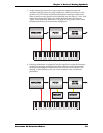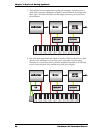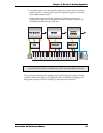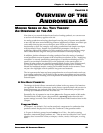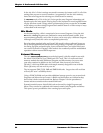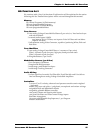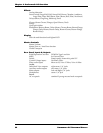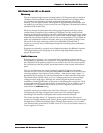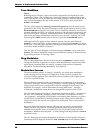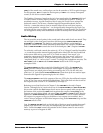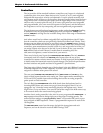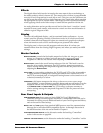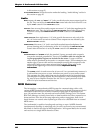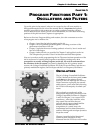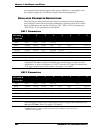
Chapter 4: Andromeda A6 Overview
ANDROMEDA A6 REFERENCE MANUAL 97
A6 FUNCTIONS AT-A-GLANCE
Memory
The A6 contains enough memory for three banks of 128 Programs and two banks of
128 Mixes. The Preset banks contain the 256 Preset Programs and 128 Preset Mixes
we created for the A6 and are stored in semipermanent memory called Flash
memory. The User bank contains 128 Programs in programmable memory that you
can modify to your liking, or use to store your own Programs (128 memory locations)
and Mixes (128 of those, too).
Mixes are memory locations that take existing single Programs and allow you to
combine them. Examples of this combining of Programs in a Mix would include
layering (two Programs played by one note), and keyboard splitting (the lower range
of the keyboard plays one Program such as a bass sound, and the upper range of the
keyboard plays another Program such as a solo or accompaniment). It is possible to
make any combination of layers and splits, with up to 16 programs playing at once.
Mix mode is also used when you want to have multitimbral control from a
sequencer, or use the A6 as a MIDI master keyboard controlling other synthesizers
and modules.
Programs are selected by using the row of buttons just above the Ribbon Controller.
The 2-digit buttons select the group of 10 and the single-digit buttons select the
specific Sound or Mix.
Audio Sources
Referring back to Chapter 3, we covered the basic ingredients of sound and the
corresponding components of a synthesizer. Using our first flowchart as an example,
the oscillators are the primary sources for raw sound in the A6. To be more specific,
the oscillators provide the periodic waveforms used to create sounds with musical
pitch.
The A6’s oscillators are true analog Voltage-Controlled Oscillators, hereinafter
referred to as the VCOs or by their panel labels
OSC 1 and OSC 2. As in the early days
of analog synthesis, the frequency of an oscillator – what musical note it plays – is
determined by the voltage it is sent by the keyboard (or other controller such as the
Pitch Bend wheel, Vibrato wheel, etc.). Low voltages produce low notes and high
voltages result in high notes. Although the A6 has a digital keyboard and also
responds to incoming MIDI data, its processor’s data stream that controls the VCOs
is converted to an analog voltage first, then is sent to the VCOs. In addition, each of
Andromeda’s VCOs produce sub-oscillation: each VCO outputs a sine wave one
octave below its
SEMITONE tuning.
Aperiodic waves are provided by the A6’s Noise Generator, a full-spectrum
(containing the full range of frequencies) noise source for creating Programs
simulating wind, thunder, earthquakes and various mechanical sounds.
The A6 also provides three 1/4” input jacks on the rear panel that allow you to
connect, for example, another synth, electric piano or guitar and process these signals
through the A6’s Filters and Output stages. Through these inputs, you can connect
your external audio to the Filters of either Voice 15 or Voice 16 (or both for stereo), or
a mono signal to all Voices.



